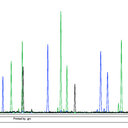Sensitivity of malignant peripheral nerve sheath tumor cells to TRAIL is augmented by loss of NF1 through modulation of MYC/MAD and is potentiated by curcumin through induction of ROS.
Schlüsselwörter
Abstrakt
Malignant peripheral nerve sheath tumor (MPNST) is a rare aggressive form of sarcoma often associated with the tumor syndrome neurofibromatosis type 1 (NF1). We investigated the effects of tumor necrosis factor-related apoptosis inducing ligand (TRAIL) on NF1 associated MPNST and determinants of TRAIL sensitivity. MPNST cell lines with complete neurofibromin deficiency were sensitive to apoptotic cell death induced by TRAIL whereas MPNST cells with retained neurofibromin expression or normal human Schwann cells were resistant. Increased sensitivity to TRAIL was associated with overexpression of death receptors, especially DR5. Re-expression of the GAP related domain of neurofibromin (NF1-GRD) suppressed DR5 expression and decreased sensitivity to TRAIL. We show that death receptor expression and TRAIL sensitivity critically depend on c-MYC and that c-MYC amounts are increased by MEK/ERK and PI3K/AKT signalling pathways which are suppressed by neurofibromin. Furthermore PI3K/AKT signalling strongly suppresses the MYC-antagonist MAD1 which significantly contributes to TRAIL sensitivity. Re-expression of the NF1-GRD decreased c-MYC and increased MAD1 amounts suggesting that neurofibromin influences TRAIL sensitivity at least in part by modulating the MYC/MAX/MAD network. The phytochemical curcumin further increased the sensitivity of neurofibromin deficient MPNST cells to TRAIL. This was presumably mediated by ROS, as it correlated with increased ROS production, was blocked by N-acetylcysteine and mimicked by exogenous ROS.


